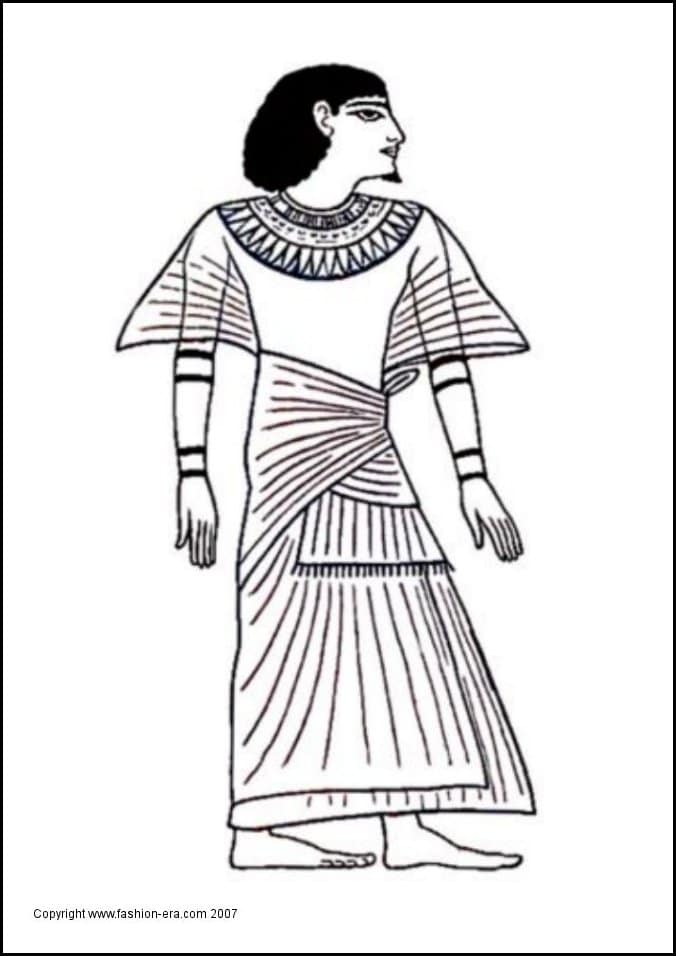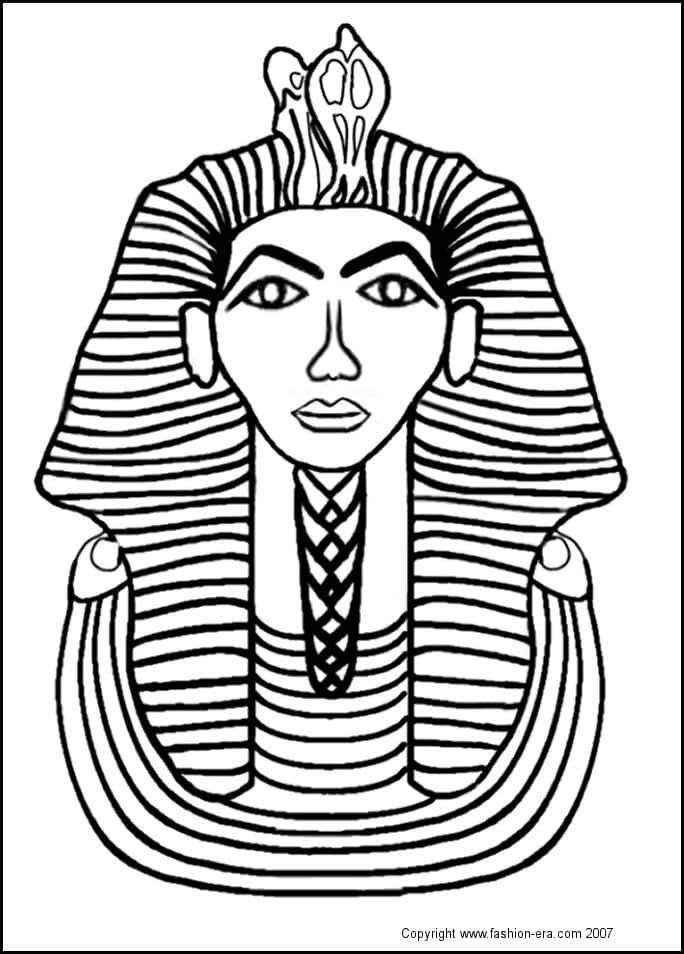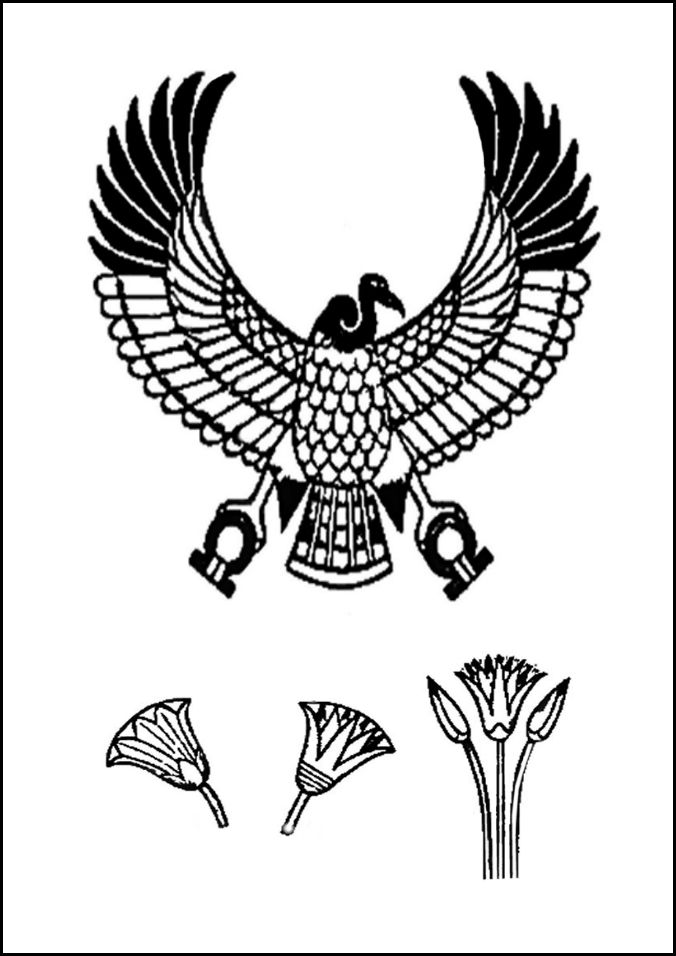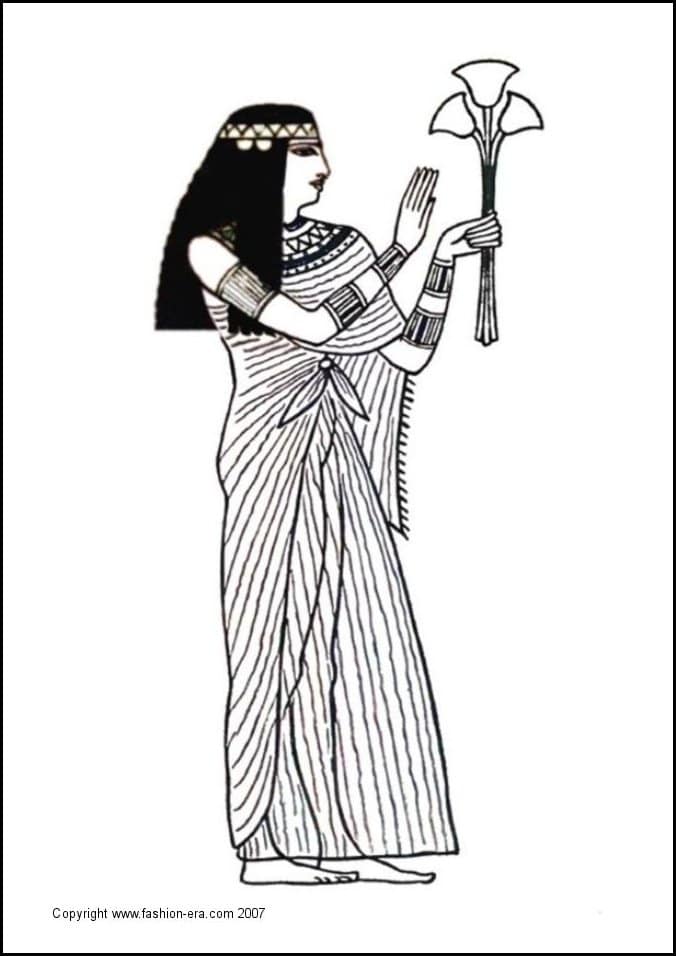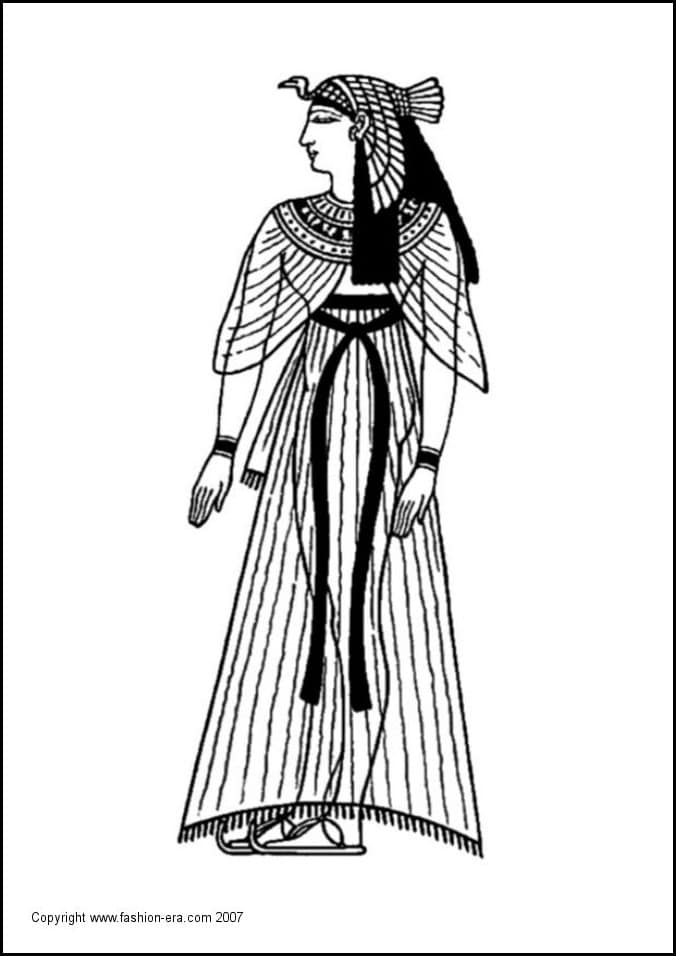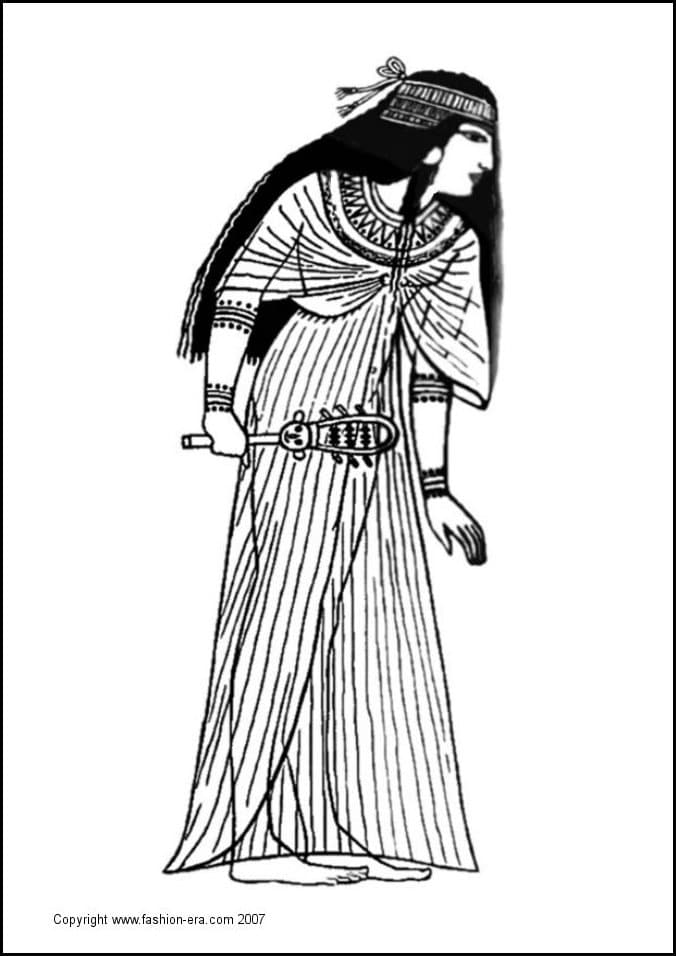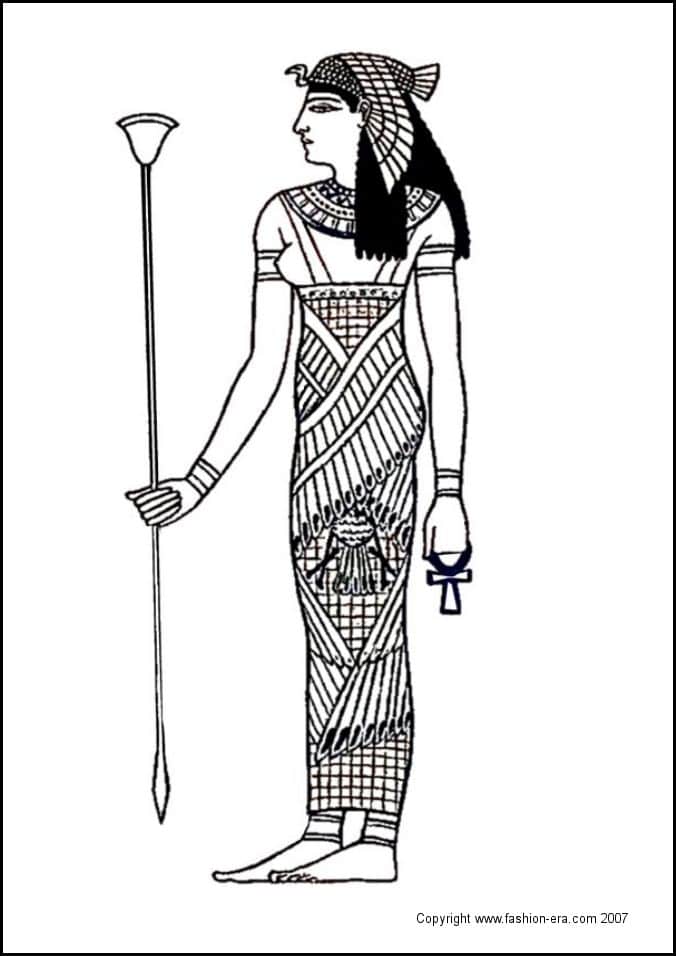By Pauline Weston Thomas for Fashion-Era.com
- King Tut and Nefertiti Costume Colouring-in Pictures
- Howard Carter Discovers King Tut in 1922
- The Old Kingdom
- Typical Egyptian Symbols and Imagery
- Ancient Egypt - Daily Life & Society
- Egyptian Gods
- Funerary Pyramids
- Giza Pyramids
Here are some free Egyptian-themed costume history colouring-in pictures for your personal use. Children can add their coloured decorative shapes to the gem bands on the King Tut funeral mask.
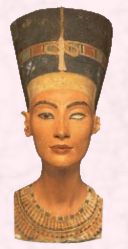
King Tutankhamun was a married boy King of 19 years when he died. His tomb was found in 1922 by the English gentleman archaeologist Howard Carter.
It is now thought by Egyptologists that Tutankhamun's father was the Pharaoh Akhenaton (occupant of tomb 55 in the Valley of the Kings) who ruled for 17 years. Shared blood grouping has suggested that Tutankhamun and Akhenaton were closely related.
Akhenaton's consort was his wife Queen Nefertiti, a most beautiful woman and the coloured statue of her head is shown right. It is this statue which confirms the use of a cosmetic product to make Egyptian lips red. You will also find a colouring-in picture of an Egyptian headdress on that page.
Later Queen Nefertiti became co-regent and power passed to her on King Akhenaton's death, before she too met her demise.
It seems Queen Nefertiti only bore daughters, and that the mother of King Tut was another secondary wife of Akhenaton. Kiya as she was called, was at one point in favour of the king until she was in turn usurped by Nefertiti.
Tutankhamun was in his teens when he married his half-sister, one of Queen Nefertiti's daughters called Ankhsenamun.
Keeping property, wealth and power closely within the family was thought to safeguard the continuance of the dynasty.
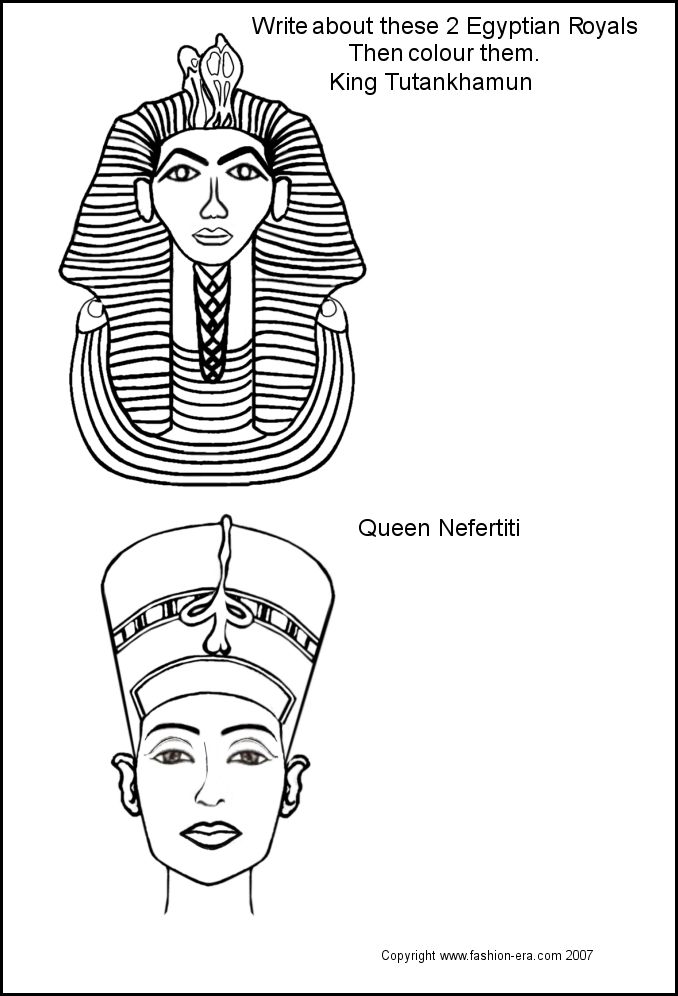
Many of the ancient Egyptian names end in 'Amun', but sometimes Tutankhamun is spelt as Tutankhamen.
The version of Tutankhamun came into general use in the UK when King Tut's exhibition first came to Britain in the early 1970s.
Suddenly, we were all told the correct way to pronounce it was with an ending sound of ahhhhh-moon!
These days he is most likely to be referred to as the abbreviated King TUT.
The abbreviation is due in part to songs about the young king. I like this shorter version of the name as this is one king that seems like an old friend, because we know so much about him. Besides texting 'Off to see King Tutankhamun at O2' may just be a tad long for today's teenager!
Howard Carter Discovered King Tut in 1922
The young royal couple had no living offspring, but two mummified stillborn babies were buried in the chamber to accompany King Tutankhamun on his journey to the spirit world.
King Tut had a magnificent tomb filled with golden treasure to keep him well contented in the afterlife. It is because of the breathtaking gloriousness of that tomb of treasure, that his name will live on forever.
The Pharaoh's body was inside 3 coffins, with a stone sarcophagus surrounding it and 4 gilded shrines. The weight of the coffin was so heavy it took 8 men to lift it. It was only when the layers were removed that the second coffin revealed itself to be solid gold.

The mummified corpse also had a separate gold mask. But the king's embalmed organs were stored apart in a nearby shrine. In all some 150 items of gold or decorative ornament were removed from the mummy and over 200 items in total made up the treasure.
The treasure included vast quantities of gold or gold inlaid items - a gold dagger, gold sandals, a wooden gold decorated inlaid throne, gold statues, carved cosmetic jars, ivory game board set, chests, boxes and various pectorals of mixed types. All unseen before and all magnificent.
Howard Carter the British archaeologist, with the backing of the fifth Earl of Caernarvon, had spent years searching for the treasure, only to discover it eventually in 1922.
Costume history lovers will all be well aware that various personalities, including Napoleon and Lord Byron have been attracted to elements of Egyptian fashion, style, design, colour and culture. But ever since 1922 the treasure and culture of Egypt and King Tut have been even more inspirational as a fresh source of design ideas.
Some consider the 1922 discovery to have been the strongest influence of later Art Deco design. Films concentrating on Egyptian themes, like the 1963 film of Cleopatra, also highlight Egyptian elements and set a new craze going whether it be eyeliner, or gold thong sandals.
The Old Kingdom
By the time King Tut came to power, Egypt was well established as a great civilisation. Much of this greatness was due to the geographical position of Egypt and its nearness to the south-eastern Mediterranean ports.
The famous Egyptian river, the Nile, also enabled lands to be kept watered and therefore fertile. In addition, people could be transported up and down the length of the river making communication and trade with nations like Assyria and the neighbouring Mediterranean coast a reality.
History informs us that the ancient Egyptian society developed from 7000 B.C., over a period of 5000 years, until we reached the Egyptian dynasty called the Old Kingdom.
By the Old Kingdom dynasty 2613-2160 B.C., the Egyptians had become used to following many gods and goddesses. They also practised elaborate rituals to look after the dead in their afterlife and they prepared for their impending death in life.
It's worth noting that few Egyptians of this period lived beyond the age of 40, so it's easy to understand why they were so preoccupied with mortality.
Typical Imagery
It is because of the elaborate funerary preparations they made, and the building of elaborate tombs to house the royal dynasties, that we know so much about the ancient Egyptians today.
Wall paintings within tombs show Egyptians going about their daily life - living, eating, grooming, dressing, writing, worshipping, building, romancing and dying.
Symbols that featured frequently in ancient Egyptian art were the vulture shown left and the scarab beetle right. Other symbols include the lotus flower, below left, and you can see more Egyptian elements on the page of decorative Egyptian ornament plates and Egyptian collars.
Other typical imagery include lions or lion heads. The half man half lion monument of the Great Sphinx at Giza is an impressive and powerful symbol of ruling royalty.
You are reading an original costume history article by Pauline Weston Thomas at www.fashion-era.com ©
Ancient Egypt - Daily Life & Society
The River Nile
Living beside the river Nile meant the Egyptians fared better than many other civilizations. The warm climate plus irrigation methods that was utilized in the Nile, enabled food to be grown relatively easily.
In early Egyptian times, the Egyptians used the simple hand-operated water mechanism called the shaduf, pronounced shadoof as a prime irrigation system.
The shaduf consisted of a pole, a container bucket for the water and a counterweight on the opposite end. This made it easy for one person to dip the shaduf into the Nile and by balancing the counterweight swing up the water and deposit the shaduf safely on the land. More complex arrangements meant water could also be passed from shaduf to shaduf.
Food and Wine
With water on hand, food was successfully grown. The ancient Egyptians grew a range of crops (emmer wheat and barley) from which they could extract a flour suitable for making bread. They also kept sheep, cows, goats and pigs for meat, fats, milk, wool and leather.
Papyrus
They cultivated grapes to make wine, and they were able to make a product called papyrus from papyrus reeds to make a material that Scribes could write on, using their specialist writing language called hieroglyphics.
Linen & Fabrics
In costume history terms, it valuable to note how they were also able to treat flax fibres, retting (rotting) them beside the river Nile, through all the necessary stages of fibre separation, right up to the natural sun bleaching process. After which, the combed flax was spun and woven into into linen cloth or made into twines.
Linen cloth bandages were used extensively in the treatment of the dead during mummification, as well as the basic material in everyday clothing for the living.
Early linens were coarser than later fine linen fabrics. Later linen materials could be spun gossamer fine and made sheer, or semi sheer like fine lawn fabrics. Wool, cotton and leather was also used.
Fashion was important in ancient Egypt, but most attention on dress for both men and women was kept for decorative collars and headdresses. There were 4 basic styles of clothing and the shapes were very simple. They wore the tunic a very simple shift, the robe, the skirt and cape or the draped shawl styles. These 4 styles developed over the centuries until all 4 styles were worn side by side.
My Egyptian clothing fashion guides are perfect if you are looking for fancy dress instructions.
Egyptian Gods
The ancient Egyptians worshipped a range of Gods and Goddesses. Some of the most famous gods include Osiris, chief judge and god of resurrection and vegetation, Isis wife of Osiris and divine mother of Horus.
Horus the soaring hawk, was the divine god and protector of the King with his all-seeing eye. Hathor the cow headed woman, the goddess of love and fertility was the wife of Horus.
Re or sometimes Ra the sun god was reborn every day and was the overall head of some nine gods. After life came death, then rebirth. Anubis was regarded as the great embalmer having first embalmed Osiris. Anubis was the guide for the dead seeking their way to the underworld whilst being the patron of embalmers and always depicted as a black jackal-headed man.
Funerary Pyramids
To prepare themselves for the period after death called the afterlife the Egyptian kings decided they needed tombs where they could have all the necessary comforts to make that afterlife journey as easy and beautiful as possible. To this end they had men build large tombs called pyramids.
Egyptologists now know that skilled craftsmen were employed as opposed to slaves and that a great deal of labouring work was carried out on the pyramids when farming work was not possible, for example during the Nile floods.
The first pyramid tomb was the Step Pyramid for King Djoser in 2680. B.C. The ancient Egyptians had a good understanding of complex geometry. The Step Pyramid was built by the great Egyptian architect Imhotep, at Saqqara. The concept behind the stepped pyramid was that the king would be able to walk his way up the steps to the gods in they sky.
Giza Pyramids
Of the 100 or so pyramids dispersed over Egypt, the pyramids at Giza are justly famous. In 2580 B.C., the Great Pyramid of Giza was built for King Khufu. It stands in sight of two smaller pyramids at 480 feet and is made from over 2,300,000 precision-cut blocks of limestone.
The pyramids became more and more elaborate with hidden chambers intended to fox thieves as each burial became more and more complex as the dynasties progressed.
We know from excavated evidence that burial chambers within the pyramid tombs were filled with all manner of domestic and personal items.
Jewels and luxurious artefacts, small boats, ornamental guard dogs and ornamental furniture both personal and household provided rich pickings for thieves and vagabonds. Tutankhamun's tomb alone was filled with some 35 boats to ensure he made a safe passage to the underworld. His tomb is one of the few found intact, giving us a rare insight into the psyche of the ancient Egyptian royals.
The majority of items were made from precious metals, precious gems, and luxury materials like onyx. Gold was abundant in the area along the Nile in Nubia, as well as on the coast of the Red Sea.
Precious and semi-precious gems and other materials were crafted into gold with sheer artistry peculiar to the Egyptian style. Favourite gems included lapis lazuli, turquoise and malachite. In addition, glass was highly prized and used mainly as a decorative bauble alongside mined gems.
Page Added 20 Nov 2007. Ref:- P663
You have been reading an original costume history article by Pauline Weston Thomas at www.fashion-era.com ©
